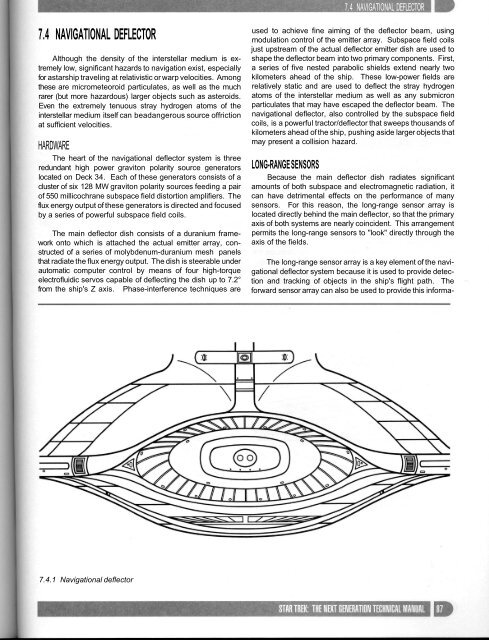franchise-star-trek-tng-technical-manual1
franchise-star-trek-tng-technical-manual1
franchise-star-trek-tng-technical-manual1
Create successful ePaper yourself
Turn your PDF publications into a flip-book with our unique Google optimized e-Paper software.
7.4 NAVIGATIONAL DEFLECTOR7.4 NAVIGATIONAL DEFLECTORAlthough the density of the interstellar medium is extremelylow, significant hazards to navigation exist, especiallyfor a<strong>star</strong>ship traveling at relativistic or warp velocities. Amongthese are micrometeoroid particulates, as well as the muchrarer (but more hazardous) larger objects such as asteroids.Even the extremely tenuous stray hydrogen atoms of theinterstellar medium itself can beadangerous source offrictionat sufficient velocities.HARDWAREThe heart of the navigational deflector system is threeredundant high power graviton polarity source generatorslocated on Deck 34. Each of these generators consists of acluster of six 128 MW graviton polarity sources feeding a pairof 550 millicochrane subspace field distortion amplifiers. Theflux energy output of these generators is directed and focusedby a series of powerful subspace field coils.The main deflector dish consists of a duranium frameworkonto which is attached the actual emitter array, constructedof a series of molybdenum-duranium mesh panelsthat radiate the flux energy output. The dish is steerable underautomatic computer control by means of four high-torqueelectrofluidic servos capable of deflecting the dish up to 7.2°from the ship's Z axis. Phase-interference techniques areused to achieve fine aiming of the deflector beam, usingmodulation control of the emitter array. Subspace field coilsjust upstream of the actual deflector emitter dish are used toshape the deflector beam into two primary components. First,a series of five nested parabolic shields extend nearly twokilometers ahead of the ship. These low-power fields arerelatively static and are used to deflect the stray hydrogenatoms of the interstellar medium as well as any submicronparticulates that may have escaped the deflector beam. Thenavigational deflector, also controlled by the subspace fieldcoils, is a powerful tractor/deflector that sweeps thousands ofkilometers ahead of the ship, pushing aside larger objects thatmay present a collision hazard.LONG-RANGE SENSORSBecause the main deflector dish radiates significantamounts of both subspace and electromagnetic radiation, itcan have detrimental effects on the performance of manysensors. For this reason, the long-range sensor array islocated directly behind the main deflector, so that the primaryaxis of both systems are nearly coincident. This arrangementpermits the long-range sensors to "look" directly through theaxis of the fields.The long-range sensor array is a key element of the navigationaldeflector system because it is used to provide detectionand tracking of objects in the ship's flight path. Theforward sensor array can also be used to provide this informa-7.4.1 Navigational deflector


